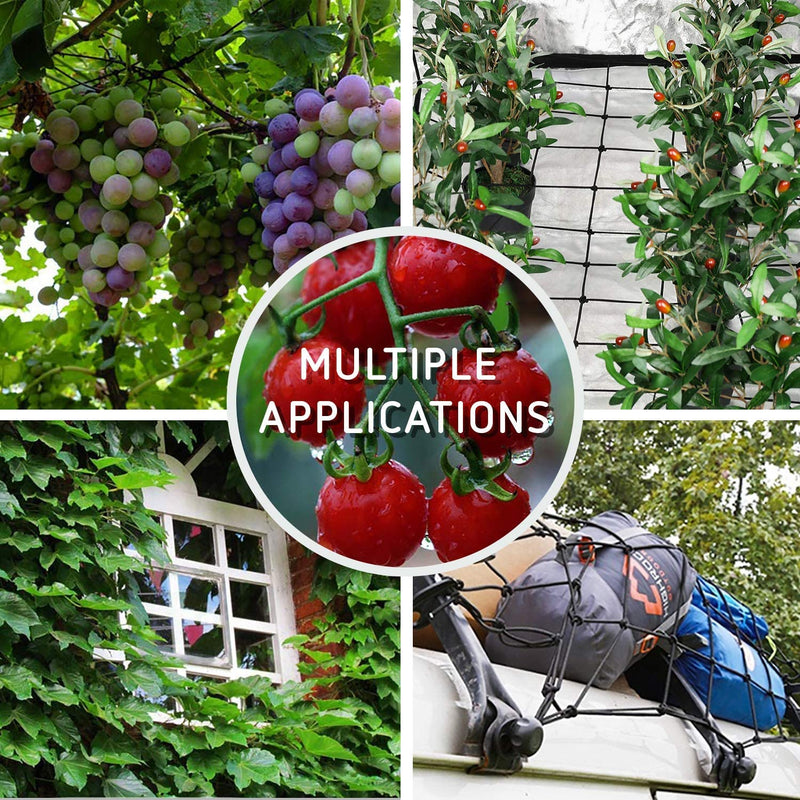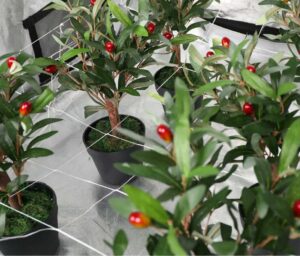The ultimate goal of a marijuana grower is to expand their yield, no matter you’re a home or commercial grower. There are a number of techniques growers focus on to improve their yields, whether it is better nutrient balance, more CO2, better air control, improved watering techniques, or different trimming techniques.
A lot of this is based on experience—for example, how, when, and where you trim your plant—but there is an especially cheap and easy method for growers to increase their yields: trellis netting. Trellising is important for your plants because it allows you to train them to grow in ways that improve yields.
So what is trellising and why is trellising important for your plants? Can just a few simple strings really help improve yields? In the following article, we’ll cover all basics about training your plants with trellis netting and give you a step-by-step guide on how to set up netting to support your plants.

What is trellising?
Simply put, trellising is using a netting structure to support and organize a plant’s growth. We set up trellis netting between metal or wooden poles, which act as a support. In the process of growing cannabis, trellising is usually divided into two categories: vertical and horizontal.
Vertical trellising is made by providing plants with a wooden or metal or plastic pole that they can use as support as they grow vertically—this is most common with vine-like plants, like tomatoes. Horizontal trellising is another popular trellis netting setup and is more common with cannabis, especially in the vegetative and flowering stages. Horizontal netting is set up from the sides of a tent and is stretched across the tent.
Normally, the netting has square holes in it that you use to both support and train your cannabis plants, to encourage them to expose more nodes to light, which in turn improves yield. Usually, vertical trellising is built at the beginning of a growing cycle, while horizontal trellising can be installed during different times of a plant’s life with the goal of allowing more points for flowering.
Finally, we have a vertical-horizontal style of setting up trellis netting that we’ll outline in the “two different techniques for trellising cannabis” section.
Why is trellis netting important for plants?
Cannabis plants tend to grow vigorously and wild, of course, this is the origin of the name “weed.” Trellising is important because it provides the spacing and direction that guide your plants, letting them know where and how to grow. The space between leaves created by netting prevents them from bud rot and mold while also exposing more node points to sunlight.
Cannabis plants, like most plants, grow towards the sun, and their branches will cluster together as this technology is more efficient for this plant. If we do not train those branches there will be not enough light for the interior branches, which in turn reduces yield potential. It is useful to use trellis netting to separate the various branches into equally spaced gaps, so flowers will have enough space to absorb the light and nutrients, helping them to grow and thrive.
Additionally, trellising not only provides uniform spacing for your plants but also provides physical support for them. Some cannabis strains grow such large buds and retain so much moisture that they may topple or break under their own weight. Netting helps support branches as they grow heavy with potent flowers.
Is trellising suitable for both indoor & outdoor growing?
Indoor and outdoor gardens and farms can both benefit from trellising. So what is the difference between trellising indoors versus outdoors? The answer depends on the size and style of your plants. Outdoor growers usually use a vertical frame made of wood or metal since outdoor plants have a lot more room to grow massive—you may have seen pictures or even visited an outdoor cannabis farm—those plants can be huge.
Indoor growers prefer using horizontal trellising because vertical space is much more limited. Indoor trellis netting is designed to help plants spread horizontally, to increase the area where buds can grow without having the plants grow too tall since getting too close to a grow light can be dangerous to a plant.

Two different techniques for trellising cannabis
Everyone who is reading this has their own growing situation, so it is hard to pin the best practice for everyone with a general guide, but we will break down the basics. The following steps might not be applicable to your garden specifically, but hopefully, it can help you get some ideas about how to set up your own trellis netting.
Vertical trellising
1. Put wood, PVC, or bamboo poles deep into the four corners of the plant pot or bed—as far as they can go while still having the poles be above the desired maximum height of your plant.
2. Stretch your trellis netting around the sticks, using tape or ropes to secure the netting to the frame, or tying it, or even using some S-hooks or zip ties. You want the netting to be taught.
3. While plants are growing, carefully push your plants’ branches through the space in the netting to provide stability and structure for them.
Horizontal trellising
- Inside your tent, you’ll be attaching your trellis netting to the support poles. Additionally, add a few poles (bamboo, PVC, or wood all work) into the soil of your pots to ensure the netting is stable.
- During the veg stage, carefully direct the tops of your plant into the numerous hole of the net, spreading them out so that all the branches of the canopies rest at the same height.
- During the flowering stage, make sure the buds have enough space by separating them with the netting, and make sure that the netting is supporting the weight of the flowers as they grow larger.
To sum up
Clearly, trellising is important for your plants—it helps spread the canopy out in a more efficient way that encourages buds to have enough space to grow. It also supports the weight of your plants as they grow large. It might seem like an unnecessary step in the process of growing cannabis, but the structure and direction of the branches will help them have better growth and yield.
If you have any questions, please don’t hesitate to reach out to us!
And be sure to check out our other blog posts for useful tips on becoming a great grower!
Subscribe to the VIVOSUN newsletter for growing tips, grower stories, and special offers, and get 12% off your first order!
We love the new VIVOSUN Smart Grow System and we are certain that you too will love it once you try it.
And join our Facebook farmer’s community for even more exclusive contests and prizes!
Download VIVOSUN App to get 18% off and explore more information!






